I have a bit of a history with the Gradius franchise. Nemesis on the Gameboy was one of the few games I owned as a child and frequently played on weekends. At the time it was one of the most challenging games I had to play, only rivaled by Mega Man on the same console. The Gradius series is notorious for its unrelenting checkpoints that strip players of their hard earned power ups. Even at a young age I had a blast learning the stages and trying to clear the game without getting hit even once, just to keep those precious upgrades and have better shots at making it through the game. Many years later Gradius Rebirth was released on the Wii Shop Channel. That game had me discover that that Gameboy game I liked so much as a kid was actually part of a franchise, and that there was a whole genre of similar games. Not much later I owned every major Gradius game on a collection for my PSP. Gradius II, IV and Gaiden were my favorites at that time. I didn't play the first and third games much back then, and since I recently decided to play my shmup library in chronological order, it made sense for me to give this one another shot.
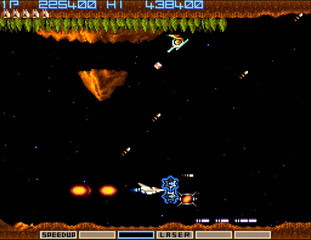
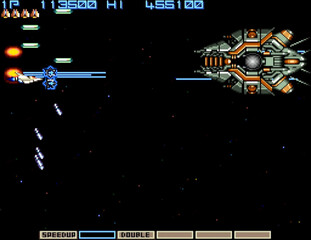
For a game of its time Gradius features surprisingly detailed graphics and complex game mechanics. Visually its first stage is still beyond anything I would have expected out of an '80s game. Its power up system, horizontal scrolling (with vertically looping stages to boot) and memorable checkpoint recovery go way beyond what Space Invaders offered. The first stage is a lot of fun to play, even by today's standards. But game overs begin piling up as early as in stage 2 where Gradius starts to get rough and demanding.
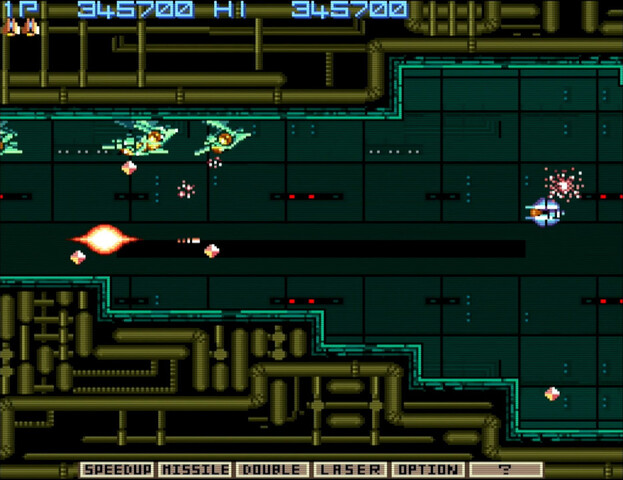
In terms of ship speed the player is left with a choice of "too slow to dodge bullets" and "too fast to accurately control". Expect to accidentally crash into terrain more than just once when you first pick this up, because the claustrophobic level design will force you to squeeze yourself through gaps narrower than is reasonable for the way the Vic Viper controls in this. The hardware this was originally developed for can barely keep up with the game's complex programming and vivid visuals. Shoot a couple of lasers with a bunch of options when there's more than one enemy on screen and the game slows to a crawl. And its framerate jumps back up just as fast when there's a moment of relieve for the hardware. Pray you weren't slowly navigating towards a wall when that happens, because you'll be flung into oblivion the moment the game finds itself running at full speed again. A frustrating way to crash out that's occured not just once over the last couple days to me.
The minimum rank rises with each stage and just as quickly scales with the Vic Viper's power. As early as stage two the game is shooting curtains of dangerously fast bullets at you if you manage to stay at full power. And by stage 3 it becomes almost impossible to recover after the slightest mistake. Gradius may have a few memorable and catchy tunes, but for the most part the soundtrack isn't a reason to remember this title (although it at least doesn't make your ears bleed like Image Fight II on the NES). In short, the game has many technical issues holding it back and making it more frustrating to play than it needs to be.
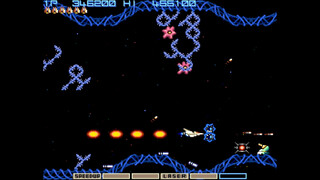
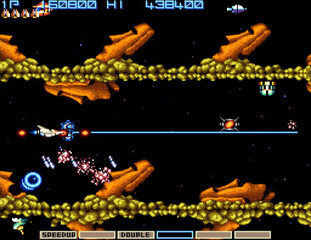
And yet I was still having a lot of fun. Recovering from a checkpoint that appears to be impossible to survive feels exhilarating, and the game becomes gradually more manageable as you build experience playing it. It didn't even take me ten hours to become consistent enough to no miss the first loop (with only one save state slot available on the Arcade Archives release). All the frustrations I had with this classic title only made me appreciate beating it all the more. I'm glad I didn't give up on the 1cc in this.
Gradius also saw a bunch of home console ports. The Deluxe Packs for the original PlayStation and Sega Saturn are noteworthy because they are noticeably easier on their default settings and come with a setting to turn off the nasty slowdowns. I imagine those are the ideal way to play this game in a less sadistic manner, and probably what I'd recommend to play over the original arcade release. However despite its technical drawbacks and sometimes frustrating design I consider this a historic classic that has you come back to give it at least one more try over and over if you're prepared to engage with it. If I didn't have a backlog of over 50 shmups to engage with I'd be continuing to improve my score in this instead of moving on already.
